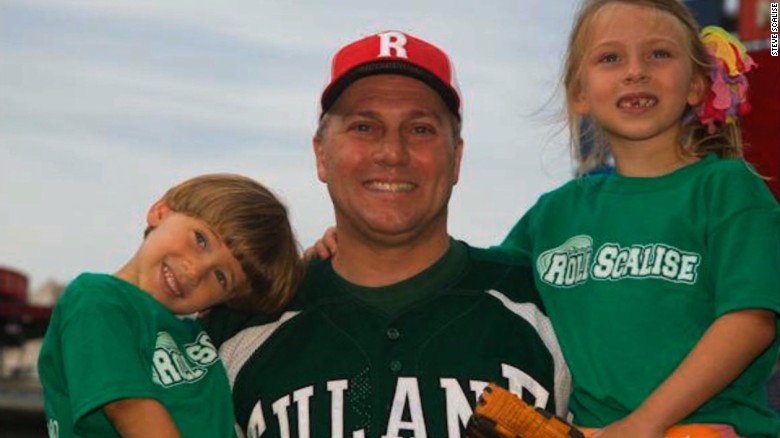 Steve Scalise, the House majority whip, at a congressional baseball practice
Steve Scalise, the House majority whip, at a congressional baseball practice
The shooting of Steve Scalise, the House majority whip, at a congressional baseball practice in Alexandria, Virginia, on Wednesday morning is just the latest in a long history of lawmakers being attacked - events that have been long overshadowed by assassinations on presidents and other heads of state.
But violence against members of Congress has occurred repeatedly since the country's founding. Fourteen lawmakers have been killed, nearly a dozen more wounded. In the early days, when politicians would regularly rumble, some congressmen initiated the violence. Among the most high-profile incidents:
August 28, 1831: Spencer Pettis, a House member from Missouri, is shot and killed in a duel with Thomas Biddle, an Army officer. The location was on an appropriately named Mississippi River sandbar: Bloody Island. They had been squabbling for months over the U.S. Bank in Philadelphia, which was run by Biddle's brother. They sniped at each other in letters to the editor. At one point, Biddle called Pettis a "dish of skimmed milk." They decided to duel, which was a bad idea for Biddle: He was shortsighted. "He named a distance so close that the pistols almost touched," one historical account said. They both lost.
September 13, 1859: California Sen. David Broderick was once friends with the Chief Justice of California, David S. Terry, but slavery tore them apart. Broderick was against it. Terry supported a candidate who was for it. Things escalated quickly. Broderick called Terry a "miserable wretch." Terry said, essentially, let's duel.
"The men met early on the morning of September 13 at Lake Merced, south of San Francisco," according to a Senate history. "After Broderick's pistol discharged prematurely, Terry coolly aimed and fired into Broderick's chest." Broderick died. Terry was tried for his murder and acquitted. Later in life, he, too, was shot to death.
October 22, 1868: James M. Hinds, a House member from Arkansas, was assassinated by a Ku Klux Klan member. Hinds was a strong supporter of Reconstruction following the Civil War. Hinds was on his horse, heading for a speech to support Ulysses S. Grant, when KKK member George Clark fired at him with a shotgun. The Morning Republican newspaper recounted the attack a week later: "Men passing and returning soon found Mr. Hinds lying in the road still alive and rational, but conscious of the fact that his wound was of such serious nature that but a few moments more remained of his earthly career." Clark fled. He was never found.
September 8, 1935: Huey Long, a traveling salesman turned Louisiana senator, served for less than four years, becoming famous for his lengthy filibusters. He had big plans and an iron fist in Louisiana politics. "Huey's consolidation of personal power led to talk of armed insurrection by his enemies," according to the Long Legacy Project. There was an unsuccessful drive-by shooting of his house. Long wanted to "gerrymander opponent Judge Benjamin Pavy out of his job." Pavy's son-in-law shot him. He died two days later. His last words: "G0D, don't let me die. I have so much to do."
March 1, 1954: Five lawmakers were shot and injured on the House floor by four Puerto Rican nationalists seeking independence. That day, shortly after lunching at Union Station, the Puerto Ricans walked to the U.S. Capitol, and made their way past security, though they were armed with pistols. They took seats in the upstairs Ladies' Gallery, and then, as more than 240 members of Congress debated an immigration bill, sprayed the House chambers with as many as 29 bullets. "Viva Puerto Rico libre," yelled the group's leader, Lolita Lebron, waving a Puerto Rican flag. The wounded representatives were: Alvin Bentley , R-Mich., George Fallon, D-Md., Ben Jensen, R-Iowa, Kenneth Roberts, D-Ala., Rep. Clifford Davis, D-Tenn.
June 5, 1968: Moments after claiming victory in California's Democratic primary, Senator Robert F. Kennedy of New York, was shot in the head at the Ambassador Hotel in Los Angeles. He was surrounded by campaign workers and journalists, including the writers Budd Schulberg and Pete Hamill. Kennedy began to shake the hand of a kitchen worker, and walk forward, when Sirhan Sirhan, a 24-year-old Jordanian immigrant living in Pasadena, California, began firing from his revolver. "We ran into the passageway, and he was lying on the cement floor, bleeding from the right side of his head," wrote Washington Post reporter Richard Harwood. "He looked dead. The kitchen erupted into madness."
January 8, 2011: Gabrielle Giffords, a House member from Arizona, was one of several people shot outside a Safeway in Tucson by Jared Lee Loughner. Giffords was one of the 13 injured who survived the attack - miraculously, given that the bullet entered her head - while six others were killed. On Wednesday, shortly after the shooting at the baseball field, the former Democratic congresswoman tweeted her sympathy for those shot and called the U.S. Capitol Police "heroes today and every day."


 Contact The Editor
Contact The Editor
 Articles By This Author
Articles By This Author